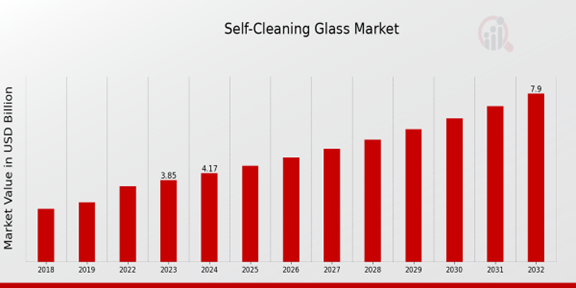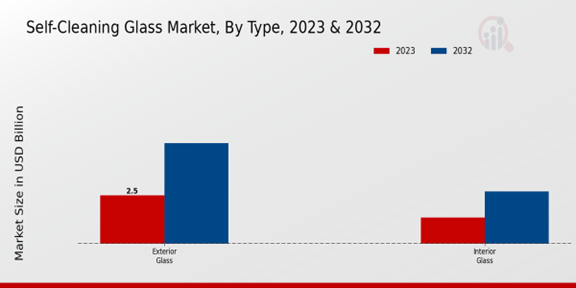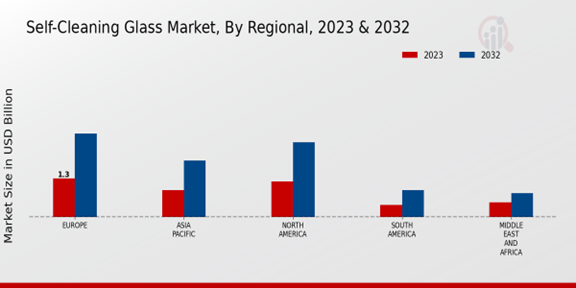Global Self-Cleaning Glass Market Overview
The Self-Cleaning Glass Market Size was estimated at 4.52 (USD Billion) in 2024. The Self-Cleaning Glass Industry is expected to grow from 4.9 (USD Billion) in 2025 to 10.05 (USD Billion) by 2034. The Self-Cleaning Glass Market CAGR (growth rate) is expected to be around 8.30% during the forecast period (2025 - 2034).
Key Self-Cleaning Glass Market Trends Highlighted
Advancements in nanotechnology are revolutionizing the self-cleaning glass industry, with increased durability and self-cleaning capabilities emerging as key trends. The growing demand for energy-efficient buildings and the need for reduced maintenance costs are driving market growth. Opportunities abound in the exploration of self-cleaning glass integrated with sensors and IoT technology, facilitating smart building management systems. Ongoing research into anti-bacterial and anti-viral coatings further enhances market prospects. The integration of self-cleaning glass into solar panels and automotive applications presents additional avenues for innovation and market expansion.

Source: Primary Research, Secondary Research, MRFR Database and Analyst Review
Self-Cleaning Glass Market Drivers
Rising Demand for Energy-Efficient Buildings
Energy-efficient buildings are becoming more and more in demand, and the construction industry is no exception. With the environment being a major concern for countries and people alike, stringent government laws and regulations are pushing the use of modern solutions. Self-cleaning glass can be added to the list with its ability to save energy, reduce the time and money spent on manual cleaning, and generally be a great addition to any building. Its popularity with architects and other builders of commercial and residential properties is expected to boost the Self-Cleaning Glass Market Industry.
Technological Advancements and Innovation
The ongoing developments in technology are constantly enhancing the performance and cost-effectiveness of self-cleaning glass. The researchers are developing improved self-cleaning coatings and other materials to make self-cleaning glass more durable, less blocked to light and more resistant to adverse weather. These developments will also expand the range of application of self-cleaning glass creating a potentially significant growth in the market.
Increasing Awareness of the Benefits of Self-Cleaning Glass
As awareness grows about the benefits of self-cleaning glass, such as reduced maintenance costs, improved aesthetics, and enhanced hygiene, demand for this technology is increasing. Educational campaigns and marketing efforts by manufacturers and industry associations are contributing to a wider understanding of the advantages of self-cleaning glass, leading to increased adoption and market expansion.
Self-Cleaning Glass Market Segment Insights
Self-Cleaning Glass Market Type Insights
The Self-Cleaning Glass Market has been delineated into key types, particularly focusing on Exterior Glass and Interior Glass. In 2023, the market was valued at 3.85 USD Billion, showcasing a substantial interest and investment in self-cleaning technologies. The segment for Exterior Glass holds a significant position within the market, with a valuation of 2.5 USD Billion in the same year. This sub-market is gaining popularity due to increasing demand in architectural applications, particularly in residential and commercial buildings where maintenance difficulties can lead to higher costs.
As a result, the Exterior Glass segment is expected to grow to 5.2 USD Billion by 2032, reflecting its robust utility and dominance in outdoor environments where cleanliness and durability are essential.
On the other hand, the Interior Glass segment, while smaller, is also critical, valued at 1.35 USD Billion in 2023. The growth trajectory of Interior Glass is less pronounced compared to its exterior counterpart, yet it plays an important role in enhancing aesthetics and functionality in indoor spaces. Its valuation is projected to reach 2.7 USD Billion by 2032, indicating a burgeoning interest in applications such as partitions, barriers, and shower doors that benefit from self-cleaning properties to foster a cleaner and more inviting indoor atmosphere. The growth in this segment can be attributed to emerging trends in design and lifestyle that favor lower maintenance solutions, aligning with consumer preferences for convenience.
Overall, the Self-Cleaning Glass Market segmentation illustrates how different types can serve various functions effectively in real-world applications. The majority holding of Exterior Glass presents it as a dominant player, directly addressing challenges related to environmental exposure and cleaning maintenance. Furthermore, the rise in residential and commercial construction projects boosts demand for such efficient solutions, solidifying the growth potential in the upcoming years while emphasizing the importance of innovation in self-cleaning technologies.
Meanwhile, the Interior Glass segment, though comparatively smaller, still offers significant opportunities for market players to tap into as lifestyle changes and design trends evolve, ensuring that the Self-Cleaning Glass Market data reflects diverse applications that critically play a role in shaping market dynamics. This reflects the promising potential and resilience of the market as it heads towards the projected figures in future years.

Source: Primary Research, Secondary Research, MRFR Database and Analyst Review
Self-Cleaning Glass Market Technology Insights
The Self-Cleaning Glass Market is projected to reach a valuation of 3.85 USD Billion in 2023, reflecting a growing interest in innovative materials focusing on convenience and sustainability. Within the technology segment, the market comprises various methodologies such as Pyrolytic, Photocatalytic, and Hydrophilic technologies, each representing unique advantages and functionalities.
Pyrolytic technology, known for its durability and effectiveness in diverse environments, has gained traction among commercial and residential users alike. In contrast, Photocatalytic technology leverages light to enhance cleaning efficiency, making it popular in urban areas where pollution is a concern.
Hydrophilic technology allows water to spread evenly across the glass surface, facilitating the removal of dust and grime, thus being favored for applications in building facades. The importance of these technologies reflects an increasing demand for maintenance-free glass solutions, driving growth in the Self-Cleaning Glass Market revenue. Factors such as rising awareness about energy efficiency, aesthetic appeal, and the need for minimal upkeep are believed to propel market growth further, presenting significant opportunities within the industry.
Insights from Self-Cleaning Glass Market Statistics highlight the competitive landscape among these technologies as consumers increasingly seek durable and efficient glass solutions.
Self-Cleaning Glass Market Application Insights
The Self-Cleaning Glass Market, valued at 3.85 USD Billion in 2023, is experiencing notable growth in the Application segment, which includes the Residential, Commercial, and Industrial sectors. The market is driven by a growing demand for low-maintenance building materials, particularly as energy-efficient designs become more popular.
Within this segment, the Residential sector plays a crucial role as homeowners prioritize convenience and aesthetics, leading to a significant uptake in self-cleaning glass installations. The Commercial sector also represents a major portion of the market, with businesses seeking to reduce maintenance costs and provide clean, modern environments.
Moreover, the Industrial sector is increasingly adopting self-cleaning solutions in factories and warehouses, enhancing operational efficiency. Challenges such as the high initial costs of self-cleaning glass technology remain, but the market also presents opportunities for innovation and technological advancements to address these issues.
Overall, the Self-Cleaning Glass Market data reflects a robust growth trajectory, driven by diverse applications that cater to both residential and commercial needs while enhancing overall market growth.
Self-Cleaning Glass Market End-Use Insights
The Self-Cleaning Glass Market has been exhibiting robust growth, with an overall market value reaching 3.85 billion USD in 2023. This growth is driven by the increasing adoption of energy-efficient and environmentally friendly building materials. Within the End-Use segment, applications such as Windows, Doors, Skylights, and Curtain Walls play a crucial role in market dynamics, each catering to various architectural needs. For instance, Windows often dominate due to their widespread usage in both residential and commercial buildings, providing aesthetic appeal while reducing maintenance efforts.
Doors are also significant, as self-cleaning technology enhances durability and cleanliness, making them a preferred choice for modern constructions. Skylights contribute to energy conservation and are gaining popularity as property owners seek natural lighting solutions, while Curtain Walls provide structural protection and are increasingly being favored in high-rise architectural designs.
Overall, the diverse applications within the End-Use segment reflect market growth opportunities, driven by the demand for convenient, low-maintenance solutions in the building industry and supported by a projected CAGR of 8.31% from 2024 to 2032.
The Self-Cleaning Glass Market data highlights not just the potential for market expansion but also insights into consumer preferences for innovations that enhance both functionality and aesthetics in contemporary building designs.
Self-Cleaning Glass Market Regional Insights
The Regional segment of the Self-Cleaning Glass Market reflects a diverse landscape, with a market value of 3.85 USD Billion in 2023. North America and Europe play pivotal roles, holding values of 1.2 USD Billion and 1.3 USD Billion, respectively, indicating their significant contributions to the overall market.
The North American sector showcases a robust growth trajectory, expected to reach 2.5 USD Billion by 2032, largely driven by technological advancements and rising demand in the construction industry. Europe closely follows, reflecting market resilience with an expected value of 2.8 USD Billion, fueled by stringent building regulations promoting energy efficiency.
The Asia-Pacific region, valued at 0.9 USD Billion in 2023, is anticipated to witness sector growth, supported by burgeoning urban developments and increased awareness of sustainability. In South America, the market is valued at 0.4 USD Billion, and while it is comparatively smaller, it shows potential for growth due to increasing residential and commercial construction activities. The Middle East and Africa, currently valued at 0.5 USD Billion, present opportunities with ongoing infrastructure projects but face challenges due to economic fluctuations.
Collectively, the Self-Cleaning Glass Market segmentation highlights varying degrees of growth and importance across regions, showcasing the dynamics influencing market expansion.

Source: Primary Research, Secondary Research, MRFR Database and Analyst Review
Self-Cleaning Glass Market Key Players And Competitive Insights
Major players in the Self-Cleaning Glass Market industry are continuously focusing on research and development of new products in order to gain a competitive edge. Leading Self-Cleaning Glass Market players are also adopting various strategies, such as mergers and acquisitions, to expand their market reach.
In addition, the use of advanced technologies such as nanotechnology is expected to drive the growth of Self-Cleaning Glass Market development. The Self-Cleaning Glass Market Competitive Landscape is characterized by the presence of both large and small players. Key players in the market include Pilkington, Saint-Gobain, Asahi Glass, NSG Group, and Guardian Industries. These players are focusing on expanding their geographical presence and developing new products to meet the growing demand for self-cleaning glass.
Asahi Glass is a leading manufacturer of flat glass, automotive glass, and chemicals. The company has a strong presence in the Self-Cleaning Glass Market industry and offers a wide range of self-cleaning glass products. Asahi Glass's self-cleaning glass is coated with a thin layer of titanium dioxide, which helps to break down organic matter and dirt. The company's self-cleaning glass is available in a variety of colors and finishes, and it can be used in a variety of applications, including windows, doors, and skylights. Asahi Glass has a strong distribution network and a presence, and the company is well-positioned to continue to grow its market share in the Self Cleaning Glass Market.
Guardian Industries is a leading manufacturer of glass, plastic, and metal products. The company has a strong presence in the Self-Cleaning Glass Market industry and offers a wide range of self-cleaning glass products. Guardian Industries' self-cleaning glass is coated with a thin layer of titanium dioxide, which helps to break down organic matter and dirt. The company's self-cleaning glass is available in a variety of colors and finishes, and it can be used in a variety of applications, including windows, doors, and skylights. Guardian Industries has a strong distribution network and a presence, and the company is well-positioned to continue to grow its market share in the Self Cleaning Glass Market.
Key Companies in the Self-Cleaning Glass Market Include
- Merck KGaA
- AGC Glass
- JX Nippon Mining Metals
- Kuraray
- 3M
- Corning
- Pilkington
- Asahi Glass
- Nippon Sheet Glass
- SaintGobain Glass
- Dow Chemical
- Guardian Industries
- PPG Industries
- Schott AG
- Heraeus
Self-Cleaning Glass Market Industry Developments
The self-cleaning glass market is projected to grow from USD 3.85 billion in 2023 to USD 7.9 billion by 2032, exhibiting a CAGR of 8.31% during the forecast period. Rising demand for energy-efficient and low-maintenance building materials, coupled with increasing environmental concerns, is driving market growth. Technological advancements, such as the development of photocatalytic and hydrophilic coatings, are further enhancing the market's potential. Key players in the industry include Pilkington, Saint-Gobain, NSG Group, and AGC Inc., among others. Recent developments include the launch of self-cleaning glass with antimicrobial properties by Pilkington and the introduction of a new generation of hydrophilic self-cleaning glass by Saint-Gobain.
Self-Cleaning Glass Market Segmentation Insights
Self-Cleaning Glass Market Type Outlook
- Exterior Glass
- Interior Glass
Self-Cleaning Glass Market Technology Outlook
- Pyrolytic
- Photocatalytic
- Hydrophilic
Self-Cleaning Glass Market Application Outlook
- Residential
- Commercial
- Industrial
Self-Cleaning Glass Market End-Use Outlook
- Windows
- Doors
- Skylights
- Curtain Walls
Self-Cleaning Glass Market Regional Outlook
- North America
- Europe
- South America
- Asia-Pacific
- Middle East and Africa
| Report Attribute/Metric |
Details |
| Market Size 2024 |
4.52(USD Billion) |
| Market Size 2025 |
4.9(USD Billion) |
| Market Size 2034 |
10.05(USD Billion) |
| Compound Annual Growth Rate (CAGR) |
8.30% (2025 - 2034) |
| Report Coverage |
Revenue Forecast, Competitive Landscape, Growth Factors, and Trends |
| Base Year |
2024 |
| Market Forecast Period |
2025 - 2034 |
| Historical Data |
2020 - 2024 |
| Market Forecast Units |
USD Billion |
| Key Companies Profiled |
Merck KGaA, AGC Glass, JX Nippon Mining Metals, Kuraray, 3M, Corning, Pilkington, Asahi Glass, Nippon Sheet Glass, SaintGobain Glass, Dow Chemical, Guardian Industries, PPG Industries, Schott AG, Heraeus |
| Segments Covered |
Type, Technology, Application, End-Use, Regional |
| Key Market Opportunities |
Rising demand in the automotive sector Increasing construction activities Growing awareness of energy efficiency High demand in developing economies Growing popularity in architectural applications |
| Key Market Dynamics |
Increasing demand for energy-efficient buildings Growing awareness of self-cleaning glass benefits Technological advancements in glass coating Government regulations promoting energy efficiency Rising construction activities |
| Countries Covered |
North America, Europe, APAC, South America, MEA |
Frequently Asked Questions (FAQ) :
The Self-Cleaning Glass Market is expected to be valued at 10.05 billion USD by the year 2034.
The anticipated CAGR for the Self-Cleaning Glass Market from 2025 to 2034 is 8.30%.
By 2032, North America is projected to hold the largest market share for Self-Cleaning Glass.
The market value of the North American Self-Cleaning Glass Market is projected to reach 2.5 billion USD in 2032.
Key players in the Self-Cleaning Glass Market include Merck KGaA, AGC Glass, and 3M.
The South American Self-Cleaning Glass Market is expected to grow to 0.9 billion USD by 2032.
The market size for Interior Glass in the Self-Cleaning Glass Market is projected to reach 2.7 billion USD by 2032.
The estimated market size for Exterior Glass in the Self-Cleaning Glass Market is projected to be 5.2 billion USD by 2032.
The Exterior Glass segment is expected to witness a stronger growth rate compared to the Interior Glass segment.
The Self-Cleaning Glass Market in the Asia Pacific region is expected to reach a value of 1.9 billion USD by 2032.

















